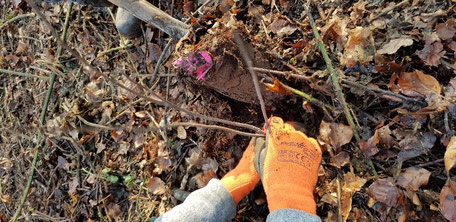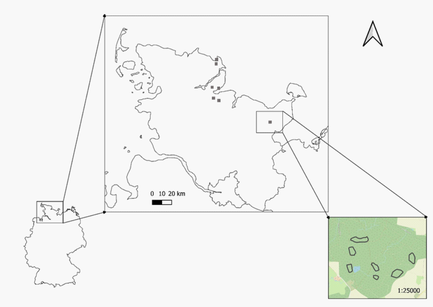FraDiv Experimental
(FraDivexp)
The extent to which the (still existing) species diversity of ash-rich forest stands can be preserved or restored is being tested experimentally using site-appropriate tree species in mixed plantings. The following tree species were chosen for this purpose:
- European ash (Fraxinus excelsior)
- White elm (Ulmus laevis)
- Small leaved lime (Tilia cordata)
- Norway maple (Acer platanoides)
- Common hornbeam (Carpinus betulus)
The plantations are located in a total of twelve forest stands of the practice partners Herzoglich Oldenburgische Forstverwaltung (HOV) and Forstbetriebsgemeinschaft Eckernförder Bucht (FEB), which were selected in 2019, each with a size of 1 to 2 ha. The experimental sites are located along an environmental gradient in which ash has a competitive advantage over other tree species, with heavily and less heavily degraded areas included in each case. The sites can be found between Gelting and Eutin in the eastern hilly region of Schleswig-Holstein.
Experimental design and setup of plots

At each of the 12 sites, 22 plots with an area of 100 m² were set up and marked out in a north-south direction. The total of 264 plots were first inventoried by the FraDiv project staff and the Myko team with regard to floristic and fungal diversity. The 22 plots within each site differ in their number of species. Heavily degraded plots, which are dominated by brambles and nettles, are generally poorer in species of vascular plants than the less heavily degraded plots.
The trees were planted in the winter of 2019/2020 and were realised as a biodiversity experiment: For this purpose, all monocultures, two-species mixtures, four-species mixtures and the five-species mixture were realised. In addition, a further plot for free succession was realised for each experimental site. Such a planting as a biodiversity experiment allows us to experimentally test the importance of species richness underneath the old-growth trees for the diversity of other taxa (fungi and plants in the herb layer): We can study mixture effects - as diversity effects and as composition effects - as well as the effects of individual tree species identities. All combinations were established once per site in random distribution and repeated across the 12 experimental sites in Schleswig-Holstein. By repeating the experimental sites, it is possible to assess the importance of different environments (e.g. according to hydrological situation, previous damage, etc.) for both the establishment success of the trees and the development of the accompanying diversity. The total number of trees planted per plot is 100 individuals. The respective proportions of each tree species in a mixture are equal.


Inventory and maintenance of the plots
Following the planting, an initial measurement of the 25,200 planted tree individuals was carried out, and has been repeated annually since then. Characteristics of the growth of the tree individuals and their damage are recorded. A survival survey of all individuals in June/July 2020 showed a high level of establishment success of the transplanted trees (survival: 96 - 99 % of trees). Standardised maintenance of all plots is currently still carried out once a year, in which all overgrowth (especially Rubus species) is trimmed in order not to endanger the establishment of the trees in the experiment and also to keep the experimental mixtures free of other emerging tree species. Annual repeat surveys of the herb layer and the fungal species present are carried out to determine the extent to which the associated diversity can best be maintained with the help of the experimental mixtures in the undergrowth of the collapsing ash stands.



This project is funded by the Federal Agency for Nature Conservation with resources from the Federal Ministry for the Environment, Nature Conservation, Nuclear Safety and Consumer Protection.

